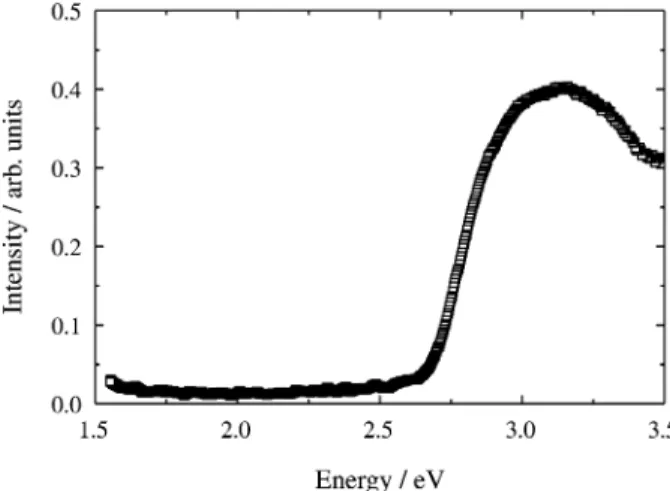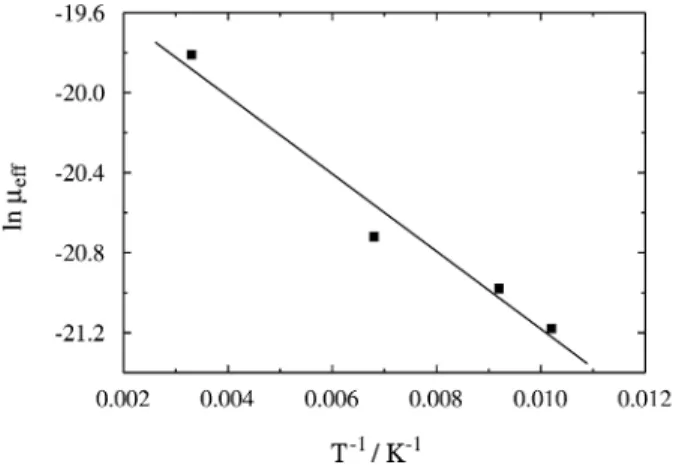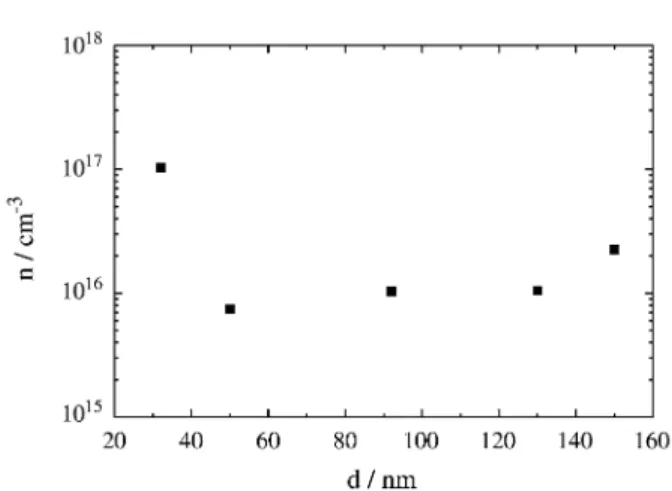Positive Charge Transport in an Alternating
Oligo-p-phenylenevinylene-derivative/aliphatic-segment Block
Copolymer
A.R.V. Benvenho, I.A. Hümmelgen*
Departamento de Física, Universidade Federal do Paraná C.P. 19044, 81531-990 Curitiba - PR, Brazil
Received: January 10, 2001; Revised: March 26, 2001
An effective positive charge carrier mobility of 4.4 x 10 -9 cm2/V.s was directly determined using analytical expressions for space-charge-limited current in poly(1,10-decanedioxy-2-methoxy-1,4-phenylene-1,2-ethenylene-3,6-dimethoxy-1,4-phenylene-1,2-ethenylene-3-methoxy-1,4-phe nylene), OPPVDBC, which is a soluble electroluminescent alternating block copolymer. Current vs. voltage measurements have been made using single carrier injection and transport in met-al/OPPVDBC/metal structures. The experimental results demonstrate that the positive charge transport in these devices is space-charge-limited and temperature dependent. Additionally, there is evidence that the evaporation of the aluminum electrode induces an increase in the charge density near the Al/OPPVDBC interface.
Keywords: block copolymer, electroluminescent polymer, charge carrier mobility
1. Introduction
Conjugated oligomers have well defined optical emis-sion and absorption characteristics, which make them natu-ral candidates for organic optoelectronic applications1. In spite of their interesting optical properties, these organic semiconductors commonly present difficulties when used in the form of thin films, due to their low molecular weight. High molecular weight materials such as polymers may present good mechanical properties, from which stable homogeneous, large area thin films can be obtained, even through technologically quite simple processes. A strategy that permits to combine the advantages of both classes of materials is to build an alternating block copolymer, con-stituted by conjugated segments (chromophores) and ali-phatic segments (spacers). The chromophores determine the optical characteristics of the polymer, whereas the spacers may improve mechanical properties, e.g. flexibil-ity, and enhance polymer solubility in common organic solvents. In this case, the spectral absorption/emission characteristics are controlled in a way similar to the vari-ation of oligomer length2,3, simply controlling the length of the conjugated segment. Additional energy shifts
(elec-troaffinity, ionization energy and energy gap) can be achieved through incorporation of substituents in the chro-mophores4-6.
In the case of organic semiconductors, charge transport properties must also be considered in order to select prom-ising candidates for device applications. Charge carrier mobility is a fundamental parameter that often controls the performance of pristine semiconductor polymer devices, its quantum efficiency, response time, current and light emis-sion threshold7. Charge carrier mobilities have again an important role in achieving balanced injection of positive and negative charge carriers and in the spatial location of the emissive region in organic light emitting diodes8,9.
For metal/polymer/metal structures, depending on a careful choice of electrode materials, injection limited (in-terface controlled) charge transport can be avoided and the transport is in fact space-charge-limited8,10,11. When the current-voltage characteristics, I(V), are space-charge-lim-ited, the charge carrier mobility can be readily determined by space-charge-limited current measurements.
In this contribution we investigate the charge transport characteristics of a electroluminescent block copolymer (see Fig. 1) using the same procedure adopted to the
char-Materials Research, Vol. 4, No. 2, 133-136, 2001. © 2001
acterization of several related copolymers investigated re-cently12-16, allowing for a direct comparison of results. In the sequence, this copolymer will be designated OPPVDBC. Since the theoretical background used in this work is the same as reported in Refs. 12-16, a detailed description of space-charge-limited transport will be omit-ted here.
At low applied voltages the charge injected through the injecting electrode does not substantially disturb the equi-librium charge carrier concentration n0 in the polymer, so that the transport is ohmic and the current density is de-scribed by17
j=qµn0V
d (1)
where q is the elementary charge, µ is the charge carrier mobility and d is the polymer film thickness.
At higher voltages and increased injection levels charge accumulates near the injecting electrode redistributing the electric field intensity, controlling charge transport through the polymer bulk and determining the I(V) dependence. In a trap-free conjugated polymer the space-charge-limited j is expressed by17
j=9
8εµ V 2
d 3 (2)
where ε is the permittivity of the polymer This charge transport case is characterized by a weak µTdependence (T: temperature). On the other hand, if traps present in the polymer layer are located at a single discrete energy level, this expression is modified to15
j=9
8εµ Nv Nt
exp (−Et−Ev
κT ), (3)
so that the effective mobility can be written as
µeff≡µ
Nv
Nt exp (−
Et−Ev
κT ), (4)
yielding a strong temperature dependence for µeff and consequently, for I. Considering the specific case of positive charge carrier transport, Nv is the density of HOMO (highest occupied molecular orbital) level states, Nt is the density of charge trapping centers, Et is the trap
center energy, Ev is the energy of the mobility edge for
positive charge carriers and k is the Boltzmann constant. Furthermore, in Eq. (1), µmust also be substituted by µeff to accomplish the single-discrete-trap case.
At the transition voltage VΩ from ohmic to space-charge limited case, the I(V) dependence follows simulta-neously Eqs. (1) and (2) or their equivalents for the single-discrete-trap case (with µeffinstead µ). For this rea-son VΩ can be used to estimate n017:
n0=9
8
εVΩ
qd 2 (5)
In all the cases described above, µ (and also µeff) is considered to be independent of the electric field strength though in some cases field dependent mobilities were also reported for several organic compounds18-21. But even in the case of field dependent mobility, this is typically ob-served only at high electric fields. For this reason, the mobility value determined in this work is the field-inde-pendent mobility.
2. Experimental
The metal/polymer/metal devices were prepared on glass substrates. The bottom metal electrode (Ni) was evaporated onto the glass and the polymer was spin coated from a CHCl3 solution (5 mg/mL) onto this electrode. The
roughness Ra22 of these OPPVDBC films was approxi-mately 10% of the sample thickness for the complete sample thickness range used (25-150 nm). The top metal electrode (Al) was then evaporated onto the polymer layer. These metals have work functions φ of ~5.1 eV and ~4.3 eV, respectively. The polymer layer thickness in all devices was measured using a surface profiler. The current-voltage measurements were made by increasing the current-voltage from zero up to the maximum value at a rate of 0.1 V.s-1 and then decreasing to zero at the same rate. Details con-cerning sample geometry were as reported earlier23. The
134 Benvenho & Hümmelgen Materials Research
Figure 1. Structure of the alternating block copolymer used in this work, in poly(1,10-decanedioxy-2-methoxy-1,4-phenylene-1,2-ethenylene-3,6-dimethoxy-1,4-phenylene-1,2-ethenylene-3-methoxy-1,4-phenylene),
permittivity of OPPVDBC was assumed to be 3ε0 (ε0: permittivity of vacuum).
3. Results and Discussion
In Fig. 2 we present the UV-visible absorbance spec-trum of the copolymer shown in Fig. 1. From the absor-bance onset the energy gap of OPPVDBC can be estimated as being ~2.6 eV.
The j(V) characteristics of a Ni/OPPVDBC/Al device show two defined regions, segments (a) and (b) (see Fig. 3). The first one (a) corresponds to ohmic behavior (j ∝ V), whereas in segment (b) j ∝V2, suggesting space-charge-limited current. Fig. 4 shows the current dependence on the OPPVDBC layer thickness, at a constant voltage V = 0.95 V. A linear fit to these data gives ∂ log I ⁄∂ log d = -3,13, quite near the theoretically expected value, -3. Since this value is determined using different samples (of different thick-ness) and that sample thickness may locally vary due to polymer film roughness, small deviations from the theoreti-cal value, -3, are commonly observed in experimental works12,15,16. The I(V,d) dependence observed in Ni/OPPVDBC/Al clearly demonstrates that the charge car-rier transport in these devices is space-charge-limited. Based on the electrode work function values and the elec-tron affinity expected for these copolymers12, we conclude that Ni/OPPVDBC/Al devices operate in a hole-only mode (only positive charge carriers are injected and transported). Using Eq. (2) we determined the value of µeff taking the data corresponding to region (b). We obtained
µeff = (4.4 ± 0.5) x 10 -9 cm2/V.s.
The temperature dependence of µeff is presented in Fig. 5. It corresponds to segment (b) of the j(V) curve of Ni/OPPVDBC/Al devices. The linear fit to the data of Fig. 4 results in ∂ ln µ ⁄ ∂T −1 = -194 K-1, which corresponds to Et - Ev = 0.016 eV [see Eq. (4)].
We could not find a proof to attribute this temperature dependent effective mobility to charge traps. Our samples do not withstand voltages higher than those applied. If higher voltages the devices suffered degradation. For this reason we could neither find a trap-filling region12 nor a hysteresis in the increasing-voltage decreasing-voltage I(V) curve, which would allow us to distinguish between another thermally activated conduction mechanism and a trap population controlled mobility, in favor of the latter. An exponential I(T) dependence can also be originated through disorder induced self-trapping of charge carriers in the polymer and it is expressed as a field dependent mobil-ity20, normally at higher electric fields, which could not be reached. However, it was observed that energetic disorder is much more pronounced in similar block copolymers with shorter aliphatic groups15. In such copolymers disorder parameters are also strongly temperature dependent15. OPPVDBC takes advantage of a long aliphatic segment, just reducing energetic disorder.
Our results can be compared with previous data on a similar copolymer, which contains the same spacer but with an OCH3 bi-substituted chromophore (the bi-substituted
Vol. 4, No. 2, 2001 Positive Charge Transport in Block Copolymer 135
Figure 4. I(d) dependence for Ni/OPPVDBC/Al devices at V = 0.95 V.
Figure 3. I(V) curve of an Ni/OPPVDBC/Al device. Device area: 1 mm2; OPPVDBC layer thickness: 92 nm; Ni positively biased.
Figure 5. Dependence of µeff on temperature. Ni/OPPVDBC/Al device;
chromophore block copolymer presents OCH3 groups only
at the central chromophore ring)16. The bi-substituted chro-mophore block copolymer has a positive charge carrier mobility of 1.3 10–10 cm2/V.s before trap filling and 1.4 x 10-8 cm2/V.s after trap filling. The mobility of OPPVDBC lies in this range, so that no definite conclusion about the consequences of introduction of two additional OCH3 groups in the chromophore on copolymer charge
carrier mobility can be inferred.
In Fig. 6 we present n0 as a function of sample thickness, determined using Eq. (5). It can be seen that except for the thinner sample, the value of n0 remains nearly independent of d, around 1015 cm-3 at room temperature. The fact that thin samples present a higher n0 value suggests that the interface neighborhood is affected during the top metal contact evaporation process inducing the appearance of additional energy levels that may increase the charge car-rier concentration in the metal electrode vicinity24.
This observation is important since electrode evapora-tion is a necessary step in device preparaevapora-tion. With addi-tional polymer-layer-depth-dependent disorder originated from the solvent evaporation, the polymer film charge transport properties can, depending on polymer, solvent and electrode preparation process, be position dependent and, as a consequence, also thickness dependent25.
4. Conclusion
Current vs. voltage measurements have been made us-ing sus-ingle carrier (positive) injection into met-al/OPPVDBC/metal structures. OPPVDBC is a soluble alternating block copolymer. Our experimental results demonstrate that the positive charge transport in Ni/OPPVDBC/Al is space-charge-limited and temperature dependent. The effective positive charge carrier mobility of 4.4 10 -9 cm2/V.s was directly determined using space-charge-limited current analytical expressions. We also found evidences that the evaporation of the aluminum
electrode induces an increase in the charge density n0 near the Al/OPPVDBC interface.
Acknowledgments
This work was supported by CNPq/PADCT under pro-ject 62.0081/97-0 CEMAT. ARVB thanks CAPES for a scholarship and IAH thanks CNPq for a research fellow-ship. The authors would like to thank Dr. Dongge Ma and Dr. Zhyiong Hong for polymer samples.
References
1. Hutten, P.F. van; Hadziioannou, G. Semiconducting Polymers, Hadziioannou, G.; Hutten, P.F. van, eds., Wiley-VCH, p. 561, 2000. 2. Geerts, Y.; Klärner, G.; Müllen, K. Electronic Materials: The Oligomer Approach, Müllen, K.; Wegner, G., eds., Wiley-VCH, p. 1, 1998.
3. Pope, M.; Swenberg, C. E.. Electronic Processes in Organic Crys-tals and Polymers, Oxford University Press, p. 5, 1999.
4. Brédas, J.L.; Cornill, K.; Meyers, F.; Beljonne, D. Handbook of Conducting Polymers, Skotheim, T. A.; Elsenbaumer, R. L.; Reynolds, J.R.; Dekker, M., eds, p. 1, 1998.
5. Yang, Z.; Sokolik, I.; Karasz, F.E.. Macromolecules, v. 26, p. 1188, 1996.
6. Gurge, R.M.; Hickl, M.; Krause, G.; Lathi, P.M.; Hu, B.; Yang, Z.; Karasz, F.E. Polym. Adv. Technol., v. 9, p. 504, 1998.
7. Redecker, M.; Bradley, D.D.C.; Karun, M.I.; Wu, W.W.; Woo, E.P. Adv. Mater., v. 11, p. 241, 1990.
8. Koehler, M.; Luz, M.G.E. da; Hümmelgen, I.A. J. Phys. D: Appl. Phys., v. 33, p. 2096, 2000.
9. Grüner, J.; Remmers, M.; Neher, D. Adv. Mater., v. 9, p. 964, 1997. 10. Ma, D.; Hümmelgen, I.A.; Li, R.W.C.; Gruber, J. J. Phys. D: Appl.
Phys., v. 33, p. 1376, 2000.
11. Koehler, M.; Hümmelgen, I.A. J. Appl. Phys., v. 87, p. 3074, 2000. 12. Dongge, Ma.; Hümmelgen, I.A.; Bin, H.; Karasz, F.E. J. Appl.
Phys., v. 86, p. 3181, 1999.
13. Dongge, Ma.; Hümmelgen, I.A.; Hu, B.; Karasz, F.E. J. Phys. D: Appl. Phys., v. 32, p. 2568, 1999.
14. Dongge, Ma.; Hümmelgen, I.A.; Hu, B.; Karasz, F.E.; Jing, X.; Wang, L.; Wang, F. Sol. Stat. Comm., v. 112, p. 251, 1999. 15. Dongge, Ma.; Hümmelgen, I.A.; Jing, X.; Hong, Z.; Wang, L.;
Zhao, X.; Wang, F; Karasz, F.E. J. Appl. Phys., v. 87, p. 312, 2000. 16. Dongge, Ma.; Hümmelgen, I.A.; Jing, X.; Wang, D.; Hong, Z.;
Wang, L.; Zhao, X; Wang, F. Braz. J. Phys, v. 30, p.392, 2000. 17. Cao, K.C.; Hwang, W. Electrical Transport in Solids, Pergamon,
1981.
18. Bozano, L.; Carter, S.A.; Scott, J.C.; Malliaras, G.G.; Brock, P.J. Appl. Phys. Lett, v. 74, p. 1132, 1999.
19. Dunlap, D.H.; Parris, P.E.; Kenkre, V.E. Phys. Rev. Lett., v. 77, p. 542, 1996.
20. Freire, J.A.; Luz, M.G.E. da; Ma, D; Hümmelgen, I.A. Appl. Phys. Lett., v. 77, p. 693, 2000.
21. Gruber, J.; Li, R.W.C.; Hümmelgen I.A. Handbook of Advanced Electronic and Photonic Materials and Devices, Nalwa, H. S., Academic Press, p. 163, 2001.
22. Whitehouse, D.T. Handbook of Surface Metrology, IOP, p. 14, 1994.
23. Roman, L.S.; Denicoló, I.; Nart, F.C.; Hümmelgen, I.A. J. Mater. Scienc. Lett., v. 15, p. 1307, 1996.
24. Simons, J.G. J. Phys. Chem. Solids, v. 32, p. 1987, 1971. 25. Koehler, M.; Luz, M.G.E. da; Hümmelgen, I. A. J. Phys. D: Appl.
Phys., submitted.
136 Benvenho & Hümmelgen Materials Research


